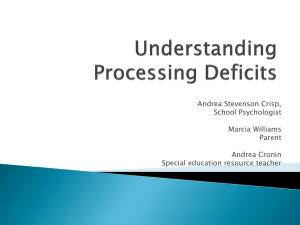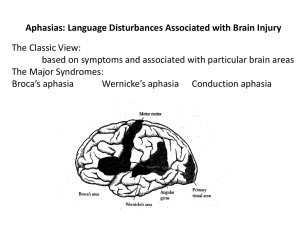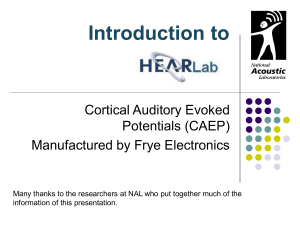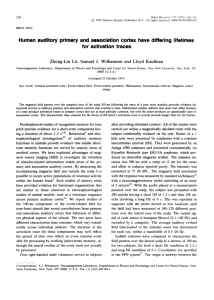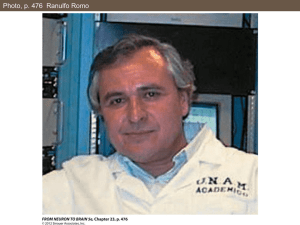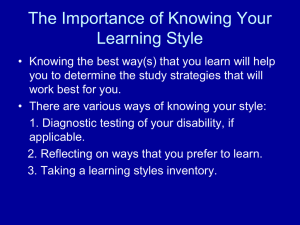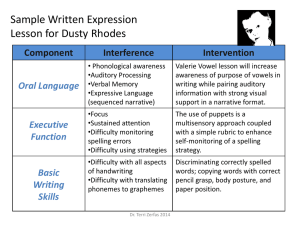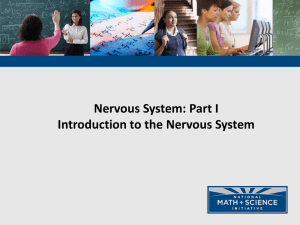Modelo experimental de la actividad neuronal en el sistema auditivo
advertisement
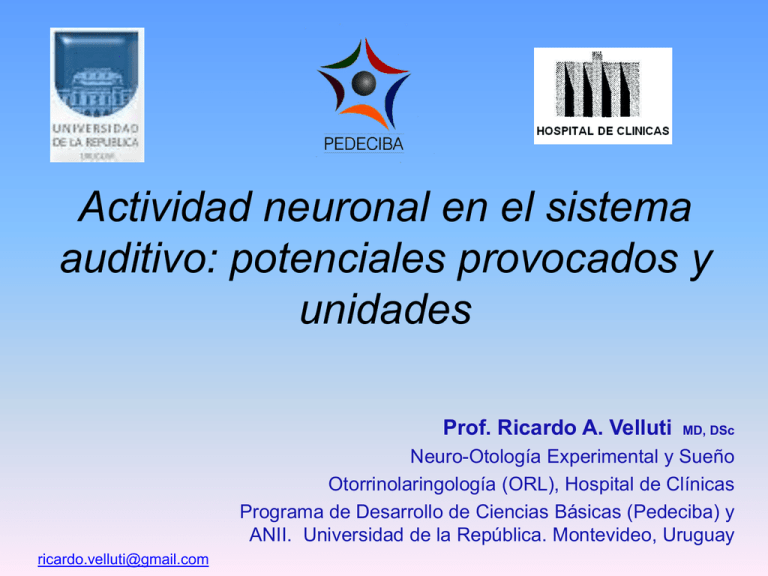
Actividad neuronal en el sistema auditivo: potenciales provocados y unidades Prof. Ricardo A. Velluti MD, DSc Neuro-Otología Experimental y Sueño Otorrinolaringología (ORL), Hospital de Clínicas Programa de Desarrollo de Ciencias Básicas (Pedeciba) y ANII. Universidad de la República. Montevideo, Uruguay ricardo.velluti@gmail.com Shannon, 1948; 1949 Information theory makes sense only if the “receiver” of signals knows the full range of possibilities. (Information transmitted in Morse code can be usefull only if the “receiver” knows that code) Information is carried out by : 1. Amplitude and waveform of evoked activity 2. Neuronal firing rate (how the brain can measure “the firing rate”? 3. A response to a transient stimulus my be carried out by the first spike or two 4. Temporal distribution of the neuronal firing, pattern of discharge 5. Relationships with other brain rhythms Information Processing Cell Assemblies/Neuronal Networks La actividad neuronal puede expresarse a través de diversas tecnologías • 1. Registro de la actividad de campo cercano: - Potenciales Provocados - Potenciales Provocados de campo lejano • 2. Descargas neuronales: - con registros intracelulares - con registros extracelulares • 3. Magnetoencefalografía (MEG) Actividad provocada • 4. Resonancia Magnética Funcional (fMRI) • 5. Tomografía por Emisión de Positrones (PET) Averaged Human Auditory Evoked Potentials A. Wakefulness B. Sleep A B García-Austt et al. 1961 El sistema Auditivo Funciona 24 horas. Auditory nerve compound action potentials HABITUATION Buño, Velluti, Handler, García-Austt, 1966 Vía Auditiva Ascendente Vía Auditiva Descendente (Eferente) Cochlear nucleus post-stimulus time histograms WAKEFULNESS A B C D 0 40 ms Toneburst Histogramas Post Estímulos Cortical Auditory Evoked Potentials in Rat Hall and Fig Borbély, 1970 5.4. Local-field and Far-field auditory evoked potentials B A Acx MG IC SO left CN SO right 20 V 1 ms Velluti 2008 Velluti, Galambos 1967 Guerit 1993 Tumor de Fosa Posterior derecha, Bulbo y Protuberancia Guerit, 1993 Potenciales Provocados de Tronco Cerebral Muerte cerebral Chiappa 1997 …but the brain is also able to be in different states – called asleep, awake, or dreaming – involving changes like receiving sensory information that are not necessarily structural, rather functional. Thus, it is still possible that learning mechanisms are ascribed to the dynamic, emergent properties of neural ensembles. We have more neurons than proteins, and perhaps the former can carry out a good job without the need of any structural modifications of their already sophisticated connectivity. Why, then, do most neuroscientists prefer to lean on neural plasticity rather than on neural functional states? J.M. Delgado García, 2008 In: Velluti, 2008 The Auditory System in Sleep, pp 135-136. A HUB neuron: In adults tends to inhibit the activity of the recipient neuron, though in developing networks, GABA has excitatory effects. They also have very extensive axonal arborisations – they project over larger distances and make a greater number of and stronger synaptic connections than non-hub neurons. Finally, they are also more responsive to inputs and quicker to fire action potentials themselves, placing them in a position to orchestrate the responses of the entire network. Though hub neurons have so far only been observed in the hippocampus it seems almost certain that they will also be found in the cortex, where their effects may be fundamental for the information processing capabilities of the brain. Bonifazi, P., Goldin, M., Picardo, M., Jorquera, I., Cattani, A., Bianconi, G., Represa, A., Ben-Ari, Y., &Cossart, R. (2009). GABAergic Hub Neurons Orchestrate Synchrony in Developing Hippocampal Networks Science, 326 (5958), 1419-1424 DOI Auditory Cortex fMRI (Portas et al. 2005) Magnetoencephalography Cortical Auditory Evoked Activity Kakigi et al. 2003 Redes Neuronales, Sueño y Audición Getting 1989 MAGNETOENCEPHALOGRAPHIC EVOKED ACTIVITY Kakigi et al. Sleep Med. (2003) Pre-Optic Region Unit Cortical auditory units McGinty 2005 Peña et al. 1999; Velluti, 2005 Events - related potentials to words Bastuji and García-Larrea, 2005 Wave P300 Wakefulness Sleep stages Bastuji, Garcia-Larrea 2005 “Mismatch Negativity (MMN)” MMN is a negative potential appearing between 100 and 200 ms as a consequence of any variation in a repetitive stream of stimuli. Its generators are in the superior temporal plane of the auditory cortex (review, Alho et al., 1995) with the addition of a frontal component (Giard et al., 1990). Extracellular recording system during Wakefulness and Sleep Guinea pig partially restrained ready for recording Auditory Cortical (A1) Neuron Velluti, Peña, Pedemonte, 2000 Cortical influences on Inferior Colliculus Auditory Neuron Goldstein-Daruech, Pedemonte, Inderkum, Velluti Hearing Res. 2002 Normal and Inverted Guinea Pig Natural Call Stimuli Auditory Cortical (A1) Recording Pérez-Perera, Velluti. Actas de Fisiología 2001 Actividad Neuronal Unitaria Intracelular Inferior Colliculus Auditory Neuron Functional Magnetic Resonance Imaging (fMRI) 1. When elements as the Hydrogen is exposed to a strong static magnetic field, the nuclei develop a net alignement in the direction of the applied field 2. A brief pulse of radio waves provide energy then the nuclei emit radio waves 3. The resonating nuclei thus became radio waves transmitters 4. The frequency of the radio waves is different in different chemical or physical environment Positron Emission Tomography (PET) Imaging of Brain Activity 1. A radioactive solution is introduced into the bloodstream 2. The radioactive substance emit positrons (electrons positively charged) producing photons of light 3. Neurons normally use glucose in their metabolism. The 2deoxyglucose is taken and its amount is proportional to their acyivity 4. Thus, the number of positron emissions indicate the neuron´s level of activity 5. Limitations: spatial resolution is only 5-10 mm; takes from 1 to many minutes to obtain; shows the activity of many thousands of neurons Phrenology (Gall 1792) 1. Phrenology is based on the concept that the brain is the organ of the mind, and that certain brain areas have localized, specific functions or modules 2. 2.Phrenologists believed that the mind has a set of different mental faculties, with each particular faculty represented in a different area of the brain. 3. …so that a person's capacity for a given personality trait could be determined simply by measuring the area of the skull that overlies the corresponding area of the brain.


